New working environments (4) - room and relationships
In the fourth part of the series New Working Environments we deal with an important component of healthy organisation - relationships at eye level. Particularly in a company, the relationships among each other are extraordinarily relevant for the quality of the cooperation.

Figure 1: The healthy organisation (Kallenbach 2016)
„A person who feels appreciated will always do more than what is expected“ Lolly Daskal.
This applies to all stakeholders in a company. The individual, the team, the managers and, of course, the customers are all related to each other.
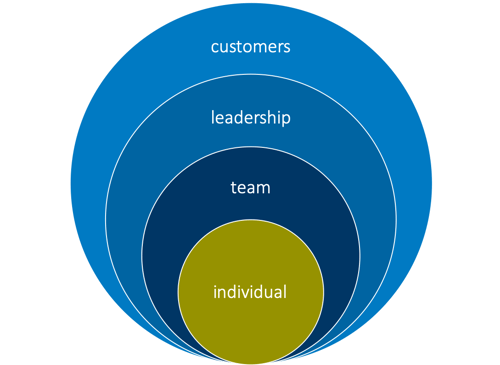
Figure 2: Interpersonal relationships in the company (Reflect)
In the context of VUCA, networked work, working in a team, is becoming increasingly important in order to be able to react agilely to the "permanent beta", the constant process of change, in the interests of the customers.
In this part of the series New Work Worlds, we look at current usage concepts from the New Work office and show possibilities of how the office should be designed so that interpersonal relationships can succeed optimally.
What do relationships mean in the context of "New Work"?
In companies, relationships describe the way communication within the organisation and at the interfaces to the outside world takes place. Relationships are part of the communication culture, can be read in communication structures and are regulated by communication processes.
The increasing self-determination of work is becoming more and more important. In particular, Generation Y, which makes up about one third of the current workforce, and future employees of Generation Z expect freedom in the organisation of their everyday working lives.
Flexible working hours, agile workplaces and home office opportunities are increasingly important criteria in the "war for talent". Respect, esteem and esteem are of great importance to the "New Work" generations.
Internally, relationships at eye level are formed through cooperation, mutual trust and support, commitment and positive presentation of the company.
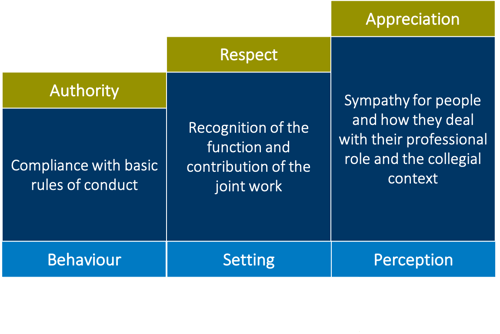 Figure 3: Eye-level relationships in the healthy organization (Kallenbach, 2016)
Figure 3: Eye-level relationships in the healthy organization (Kallenbach, 2016)
In an ailing organization, one often finds arrogant and submissive or exploitative and "win-less" relationships.
Externally in the quality of interaction with stakeholders through fairness, adherence to compliance rules, recognition of diversity, long-term partnerships and the assumption of social responsibility.
Relationships are highly dependent on the way in which they are applied. This has changed in many companies due to digitization, but the spatial concept has often not yet changed.
Three different types of relationships can be distinguished, each of which shapes the way we work together: classical working, activity-based working and agile Woring.
Classical working:
This type of leadership dominated the way people worked together until the end of the 20th century, in some cases even to this day. It is a conservative approach with a pronounced hierarchy. The boss delegates tasks to the employee, there are clear roles and responsibilities. The personal responsibility of the employees is usually low.
This way of working rather inhibits creativity and innovation. For some areas, it should be mentioned, where clear structures are helpful, this way of working is still useful and effective.
Today's office equipment, however, often dates back to this time. Conventional, inflexible and not conducive to communication between people.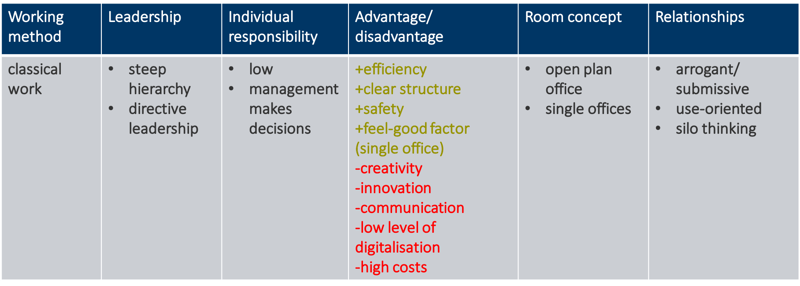
Figure 4: Classical working
Activity-based working:
Google and Amazon are leading the way - but this way of working is also becoming increasingly common in Germany. The concept is by no means new; its beginnings go back to the 1970s.
With activity-based working, employees choose the working environment that suits their working modes (telephoning, concentration, meetings...) and also decide on the working hours and the appropriate methodology.
In these multispace concepts, the employee chooses the room according to his or her activity. If the employee needs to make a telephone call, he uses a quiet room. For working with colleagues, there is a large space to keep the arrangements short and agile.
Ideally, the manager does not sit isolated in an individual office, but rather in the space with the team in the middle. Meetings and design thinking sessions are held in meeting rooms or lounges. The company provides a working environment that is suitable for all work modes.
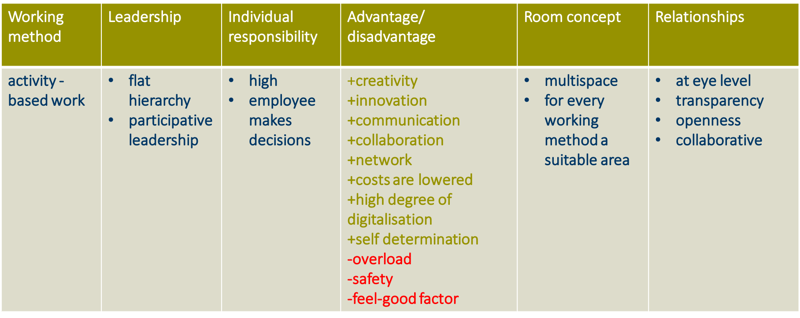
Figure 5: Activity-based working
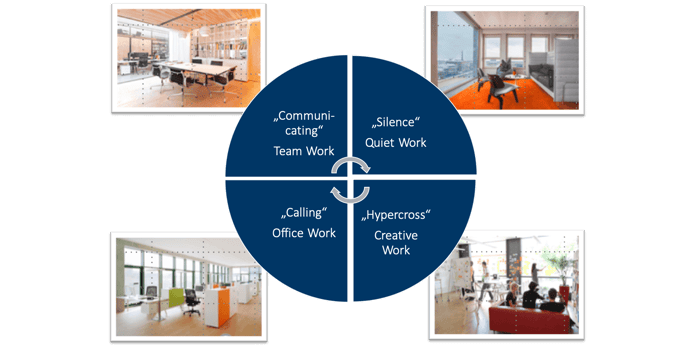
Figure 6: Working modes in activity-based working
Agile Working:
If the company works very closely together in teams, agile working is the best option. Agile teams choose the working environment that suits them and can design it according to their needs for successful teamwork.
In this working method, the team also decides on the joint working time and the methods to be used (Srum, Kanban, Design Thinking etc.). There are also risks in this type of cooperation. Especially for very introverted people, it can be difficult not to be able to withdraw, but mostly to interact with others.
There is also the danger that employees do not take sick leave because their working hours are self-determined and they do not pay enough attention to themselves.

Figure 7: Agile working
Conclusion:
The predominant working method (classical working, activity-based working or agile working) in the company determines the working time, place and method of work.
The working environment has a considerable influence on whether relationships - and thus the way a company works - can succeed. Consider specifically whether employees in your company are treated unfairly because of their workplace.
- Who gets a seat by the window, who sits next to the noisy kitchen? Often a clear hierarchy can be seen. Therefore, make sure that there are no "better" seats or rotate them continuously.- Executives sit with their team, interaction is at eye level and characterised by respect and appreciation.- Don't underestimate the risks of agile working - the excessive demands on employees. Train your employees and teams - despite self-determination and shared responsibility - to take care of themselves and the team members. - Those who are ill should recover, rest periods should be observed.- As always, the way in which managers act on behalf of others determines the success of the desired change.
Recommended reading:
New working environments (part 3) - room and leadership 4.0

